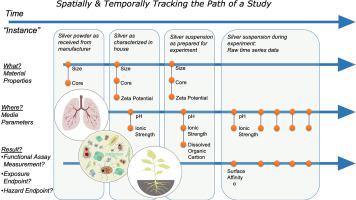NanoImpact ( IF 4.7 ) Pub Date : 2021-06-12 , DOI: 10.1016/j.impact.2021.100331 Jaleesia D Amos 1 , Yuan Tian 1 , Zhao Zhang 1 , Greg V Lowry 2 , Mark R Wiesner 1 , Christine Ogilvie Hendren 1

|
The empirical necessity for integrating informatics throughout the experimental process has become a focal point of the nano-community as we work in parallel to converge efforts for making nano-data reproducible and accessible. The NanoInformatics Knowledge Commons (NIKC) Database was designed to capture the complex relationship between nanomaterials and their environments over time in the concept of an ‘Instance’. Our Instance Organizational Structure (IOS) was built to record metadata on nanomaterial transformations in an organizational structure permitting readily accessible data for broader scientific inquiry. By transforming published and on-going data into the IOS we are able to tell the full transformational journey of a nanomaterial within its experimental life cycle. The IOS structure has prepared curated data to be fully analyzed to uncover relationships between observable phenomenon and medium or nanomaterial characteristics. Essential to building the NIKC database and associated applications was incorporating the researcher's needs into every level of development. We started by centering the research question, the query, and the necessary data needed to support the question and query. The process used to create nanoinformatic tools informs usability and analytical capability. In this paper we present the NIKC database, our developmental process, and its curated contents. We also present the Collaboration Tool which was built to foster building new collaboration teams. Through these efforts we aim to: 1) elucidate the general principles that determine nanomaterial behavior in the environment; 2) identify metadata necessary to predict exposure potential and bio-uptake; and 3) identify key characterization assays that predict outcomes of interest.
中文翻译:

NanoInformatics Knowledge Commons:捕获不同系统中的空间和时间纳米材料转换
在整个实验过程中整合信息学的经验必要性已成为纳米社区的焦点,因为我们并行工作以集中努力使纳米数据具有可重复性和可访问性。NanoInformatics Knowledge Commons (NIKC) 数据库旨在以“实例”的概念捕捉纳米材料与其环境之间的复杂关系。我们的实例组织结构 (IOS) 的构建是为了在组织结构中记录有关纳米材料转变的元数据,该组织结构允许轻松访问数据以进行更广泛的科学调查。通过将已发布和正在进行的数据转换为 IOS,我们能够了解纳米材料在其实验生命周期内的完整转变过程。IOS 结构已准备好要全面分析的精选数据,以揭示可观察现象与介质或纳米材料特性之间的关系。构建 NIKC 数据库和相关应用程序的关键是将研究人员的需求融入到开发的各个层面。我们首先集中研究问题、查询以及支持问题和查询所需的必要数据。用于创建纳米信息学工具的过程为可用性和分析能力提供了依据。在本文中,我们介绍了 NIKC 数据库、我们的开发过程及其策划内容。我们还展示了协作工具,该工具旨在促进建立新的协作团队。通过这些努力,我们的目标是:1)阐明决定纳米材料在环境中行为的一般原则;2) 识别预测暴露潜力和生物吸收所需的元数据;3) 确定预测感兴趣结果的关键表征分析。











































 京公网安备 11010802027423号
京公网安备 11010802027423号